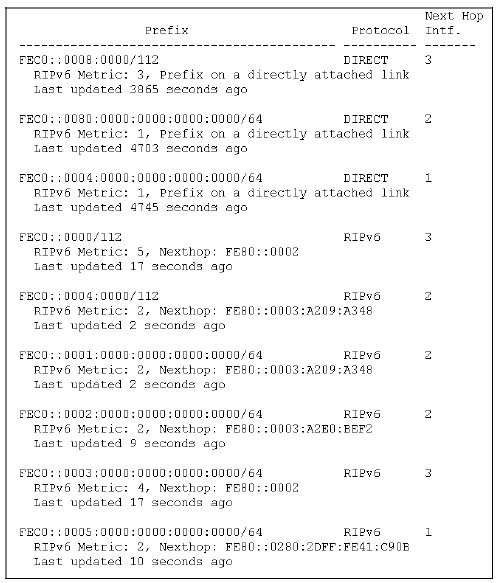Section 8.1. The Routing Table
8.1. The Routing TableEach router maintains a routing table (also known as forwarding table). Each entry represents an IPv6 destination, from now on called an IPv6 route. Each IPv6 route in the table is stored in the form of an IPv6 address prefix and its length. For each IPv6 route, additional information is stored in the routing table. The next hop information, for instance, tells the router where to forward a packet destined for this particular IPv6 route. Another type of information would be the metric of the IPv6 route, allowing the router to select the best path (smallest metric) to each IPv6 route in case of multiple entries.
8.1.1. Routing Table Lookup and ContentFor each incoming IPv6 packet, the router inspects the Destination address and looks it up in the routing table. For each IPv6 route in the routing table, the router applies the prefix length to the Destination address to calculate a Destination address prefix. If this calculated prefix corresponds with the prefix of the IPv6 route, a match was found. To optimize the lookup, the searching algorithm looks through the entries based on prefix length, starting with longest prefix. If a match was found, the rest of the routing table can be ignored, as the longest matched prefix is always the preferred IPv6 route. Of course, this is a simplified representation of the lookup process. The actual algorithms behind it are complex and highly optimized. Once the router has found a matching entry, the datagram is forwarded according to the next-hop information associated with this entry. In addition, the value of the hop limit within the datagram's IPv6 header is decremented by one. If no match is found in the routing table or the hop limit value has reached zero, the datagram is dropped. Figure 8-1 shows an example of such a routing table. Figure 8-1. An IPv6 routing table For each route, the router keeps the following entries in the routing table:
8.1.2. Default RouteA default route represents a route to all Destination addresses that are not explicitly listed in the routing table. It can be used when a router does not need to know all destinations specificallyfor example, a router connecting a remote branch office to the main site. It does not need to know all routes of the entire autonomous systems. It only needs to know the local routes of the remote office; all other routes can be reached only via the connection to the main site, hence a default route. A default route must be entered into the routing table just like any other route. The Next Hop address of the default route is also called the default router or default gateway. The entire data traffic for unknown routes is sent to the default router. It is assumed that the default router knows all the routes or has a default router itself. It is at the discretion of the network designer to determine whether and how such a chain of default routers should be implemented. The top router of such a chain is typically a boundary router to another network area or autonomous system. It is here that the default route is entered statically and then distributed over the appropriate network area via a routing protocol. The advantage of distributing the default route is to reduce the number of routing updates to be distributed throughout the network area. Default routes should not be propagated further than intendedthat is, they should not leave the network area or the autonomous system. A metric is assigned to the default route at its origin to establish precedence among multiple default routers. Default routes and distribution must be planned and implemented with care to avoid routing inconsistencies. Any prefix with a length of zero is considered to be a default route, but normally an IPv6 prefix of 0:0:0:0:0:0:0:0 (or simply ::) with a prefix length of zero is used. A Destination address of an incoming datagram will always match the default route, as the number of relevant bits for comparison is zero. The default route, however, is always the last route in the routing table, and hence a match is found only if no other routes in the routing table produce a match.
|
- Integration Strategies and Tactics for Information Technology Governance
- Assessing Business-IT Alignment Maturity
- Linking the IT Balanced Scorecard to the Business Objectives at a Major Canadian Financial Group
- Governance in IT Outsourcing Partnerships
- Governance Structures for IT in the Health Care Industry
